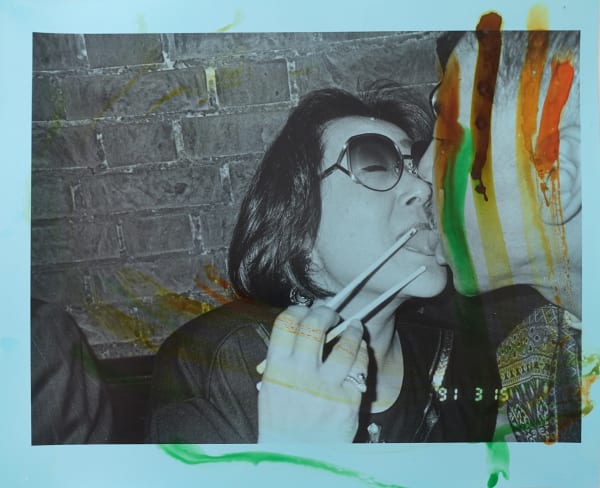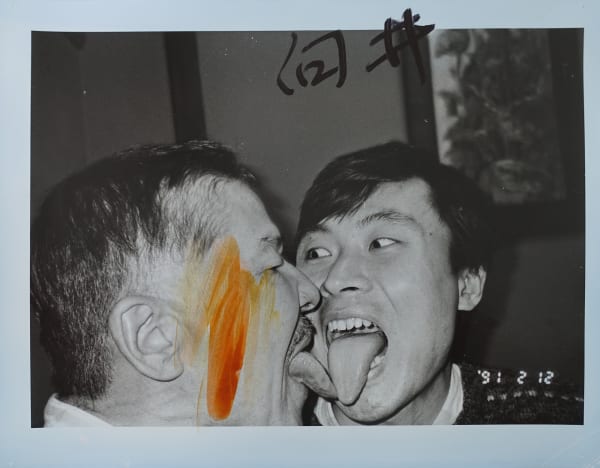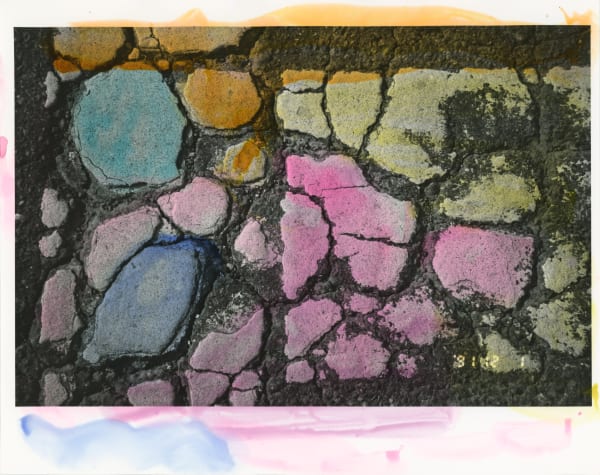‘I gave this series the name Private Scenes because everybody and everything I photograph is a projection of myself.’
– Fukase, 1990.
-
In 1992 Masahisa Fukase was the subject of a solo exhibition at Tokyo’s Nikon Salon. Showing pictures taken between 1990 and 1992, these series were to become Fukase’s last works before he suffered a fatal accident in the months following the exhibition. Private Scenes ’92 illustrated an important conclusion to Fukase’s lifelong struggle with the limits of his medium; Of the 450 prints hung with drawing pins at the Nikon Salon, every picture constituted a self-portrait. Our exhibition reflects the legacy of this final show, bringing together three series which Fukase created concurrently and intended for display together.
The centrepiece of the exhibition was a body of work entitled Berobero, an onomatopoeic word which refers to both tongues and licking. In these self-portraits, Fukase captured himself touching tongues with men and women of all ages, many of whom he encountered in bars around Shinjuku in Tokyo.
-
BEROBERO
-

-
Already a renowned member of Japan’s photography community, Fukase captured himself in the company of many of his famous peers, including Daidō Moriyama, Ishiuchi Miyako and Nobuyoshi Araki. Fukase was no longer focussed on technical virtuosity or visual coherence, instead concentrating on the direct relationship between photographer and subject, and the experience of capturing this interaction.
-
BEROBERO - AVAILABLE WORKS
-
HIBI
-
If the pictures from Berobero show a record of Fukase’s drunken nights, photographs from the adjoining series Hibi provide a visual document of his solitary days walking around Tokyo. The images are aesthetically linked by Fukase’s embellishments in watercolour paint and ink, this time applied in abstract patterns across the surface of pavements and asphalt. His physical presence in these pictures is understated, using thumbprints and shadows to hint at his experience of ‘walk[ing] with my head lowered, looking at the cracks in the ground.’
Many Japanese photographers, most notably Shōmei Tōmatsu and Kikuji Kawada, created abstract compositions based on the ground, focussing on the textural variation and evidence of decay they saw around themselves. By capturing the surface on which they stood, artists like Tōmatsu and later Fukase were creating records which affirmed the presence of their perspective in the material world as well as the camera’s unique capacity to translate this reality.
Fukase may have been influenced in his adoption of the hand-colouring process by his contemporary, Nobuyoshi Araki, who had experimented widely with paints and calligraphic additions in his work from the same period. During this time of introspection Fukase returned to some of his own archival photographs from as far back as 1972 to retrospectively add the colours which lend his late photography its characteristic intimacy and emotion.
-
HIBI - AVAILABLE WORKS
-
PRIVATE SCENES
-
The exhibition title Private Scenes was taken from an earlier series which Fukase undertook at the close of the 1980s, and which he revisited for his display in 1992. During travels which encompassed trips to Paris, London, Brussels, Antwerp, Pompeii and India, Fukase had begun to take pictures of himself before a changing landscape, in a style similar to today’s ‘selfies’.
-

-
Fukase had come to embrace photography as an act of inescapable self-expression. Having shied away from public appearances and declamatory statements throughout his career, after 1990 Fukase became more open to discussions about his life and work. The existential conclusions pointed at his exhibition appear to have clarified his attitude, so that he was free to turn away from those closest to him and indulge in an extensive exploration of his own identity.
-
‘Unlike anything else he photographed, whether it was animals like ravens and cats, or the people around him like his wife or immediate family, the self-portraits that he took during his later years express his self-representation point of view unlike anything else.’
- Tomo Kosuga, Masahisa Fukase Archives, 2018.
-
PRIVATE SCENES - AVAILABLE WORKS



























